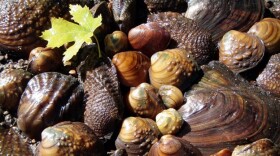One of my college professors and mentors, Professor Glen Stanosz used to say that all an ecosystem needs to function are producers (plants) and consumers (fungi). All the insects, birds, and mammals (including humans) are noise in the middle and not really necessary. Let’s look at the forests of Northern Wisconsin and see how these producers and consumers interact.
It's fall. Many of us have finished up our yard work for the season and are ready for old man winter. In fact, I have my snow shovels strategically placed by garage and sidewalks. One task that we are finishing up with at Kemp Station is leaf removal around the buildings and grassy areas. What happens to all the fallen leaves in the forest? How do they disappear so quickly? This is where our fungal consumers come in.
Leaf litter decomposition is a key process in many ecosystems, recycling nutrients back into the soil. The rate at which leaf litter decays is influenced by factors, including temperature, leaf litter traits, environmental conditions, and fungal communities. It stands to reason that leaf litter decomposes more quickly in warmer temperatures. Leaf litter traits, such as its lignin content, affect how quickly it decomposes. Low lignin material decomposes more quickly than lignin-rich litter. The type of environment, such as whether it's terrestrial or aquatic, can affect the rate of decomposition. For example, litter decomposition might be slower in wetlands due to the anaerobic environment. Remember that fungi need oxygen to survive, so leaf litter under water will not decay. Also, leave will decay slowly in very dry environments, so the balance of moisture and temperature is important. Finally, there are more organisms at work than just fungi. Forest litter serves as a home for invertebrates such as millipedes, centipedes, and ants, as well as microorganisms such as the afore mentioned fungi and bacteria. All these creatures help break down the litter into materials that can be reused by other organisms within the forest ecosystem. In most cases, final leaf litter decomposition will take more than one season. Little or no decomposition will take place for 4 or 5 months during the winter season.
As the forest litter decays, it returns nutrients to the soil. During the final stage of decomposition, bacteria break down organic materials into their simplest inorganic forms, which include water, carbon dioxide, nitrogen, and other soil minerals; this process is called mineralization. Through mineralization the dead components of a forest are recycled to provide the living trees and plants with materials that are essential for their growth and development. Every gardener knows the importance of adding organics to their soil. The same process occurs naturally in our northern forests
Leaf litter fungi differ from wood decay fungi, as they have distinct species compositions and adaptations due to the different chemical makeup of leaf litter vs. wood. Leaf litter fungi often being more efficient at breaking down simpler compounds found in leaves while wood decay fungi specialize in breaking down complex lignin and cellulose structures within wood.
Leaf litter decomposition is often dominated by Ascomycete fungi, while wood decay is more commonly associated with Basidiomycete fungi, particularly white-rot and brown-rot species. Leaf litter fungi produce enzymes better suited for breaking down easily degradable leaf components like sugars and simple carbohydrates, whereas wood decay fungi produce enzymes that target lignin and cellulose, the main components of wood. Leaf litter often decomposes faster than wood due to its readily available nutrients.
Wood decay fungi are often viewed negatively as they can damage structures and property, but it is clear that specialized leaf litter fungi play a crucial role in consuming and recycling the autumn Northwoods leaf fall.









